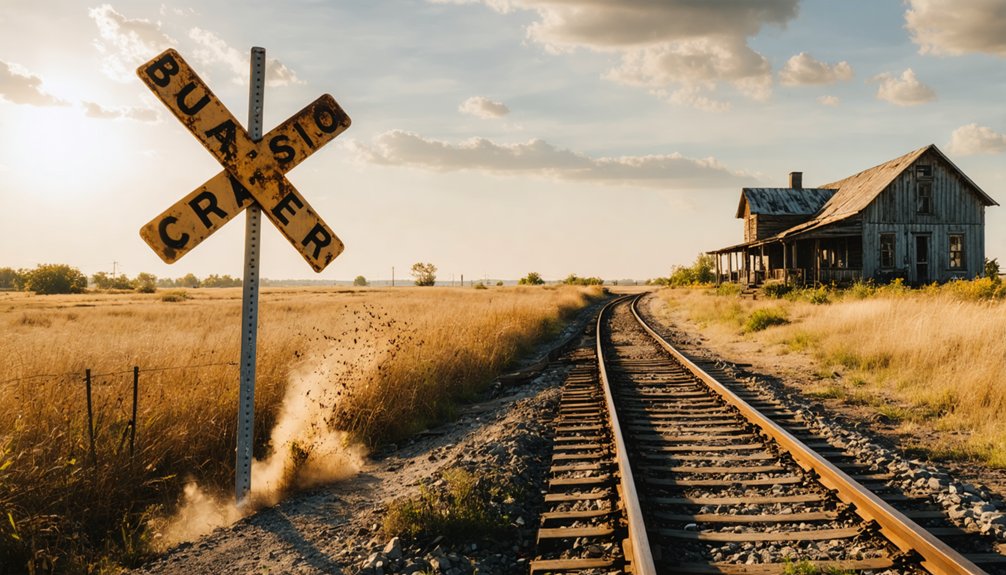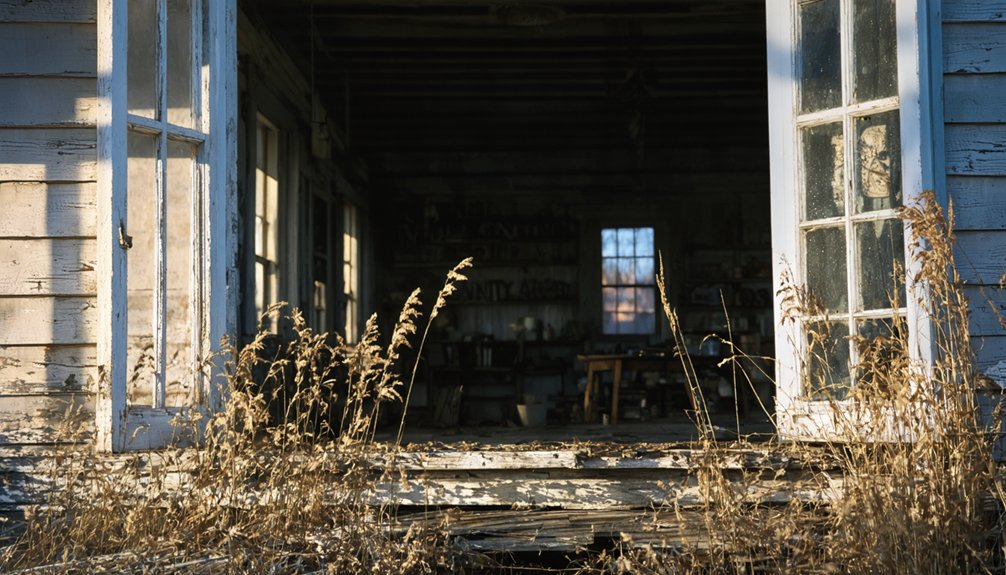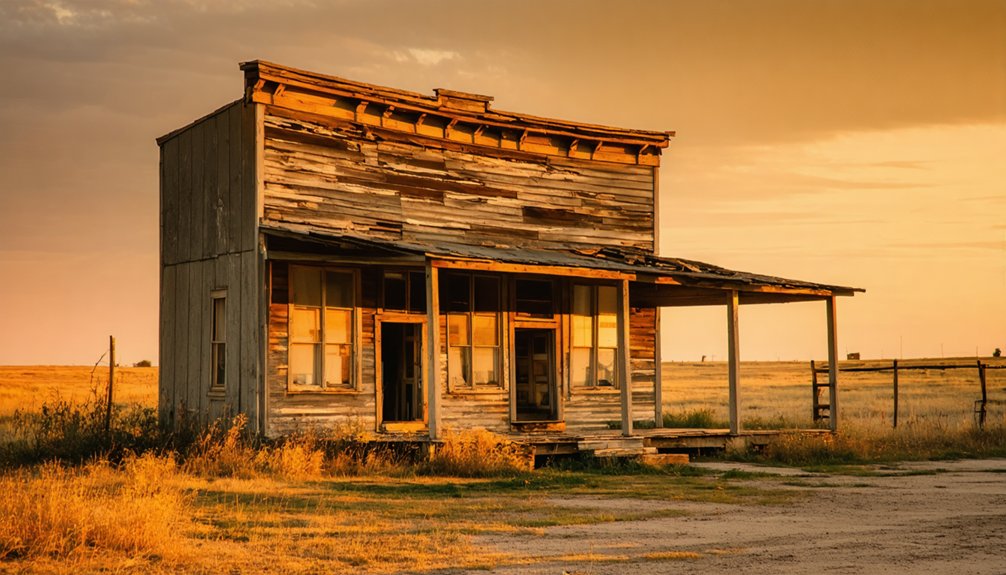You’ll find Centennial Park nestled in South Dakota’s Black Hills, where gold fever sparked a boom town in 1875. The settlement flourished with miners, railroad workers, and their families living in wooden cabins near mining claims. The Homestake Mining Company dominated local employment after 1877, with weekly yields reaching $70,000 during peak production. Today, weathered foundations and rusted mining equipment tell stories of frontier dreams among the scattered remnants of this abandoned community.
Key Takeaways
- Centennial Park originated during the Black Hills gold rush, with its population primarily consisting of prospectors and railroad workers.
- The ghost town features scattered foundation stones, deteriorated building footprints, and abandoned mine shafts from its mining heyday.
- Weekly gold production during peak operations yielded $10,000-$70,000, driven by the Homestake Mining Company established in 1876.
- The site includes remnants of a commercial district with stone foundations revealing general stores, saloons, and office buildings.
- Modern preservation efforts began in the 2000s, utilizing digital archiving and ground-penetrating radar to document remaining historical structures.
The Origins of Centennial Park’s Settlement
While the Black Hills gold rush of the late 19th century spurred widespread settlement throughout the region, Centennial Park’s establishment emerged specifically from the confluence of mining prospects and railroad expansion.
You’ll find that settlement patterns followed the typical boom-town trajectory, with prospectors and railroad workers forming the initial population base. The area’s rich mineral deposits and strategic location along newly-laid rail lines proved irresistible to those seeking their fortune. The introduction of Concord stagecoaches helped connect these emerging settlements to larger trading networks.
Population dynamics shifted rapidly as mining camps sprouted up, drawing diverse groups of immigrants and workers. Following patterns similar to ghost towns like Rockerville, the community experienced rapid growth during its early mining days.
The Black Hills mining camps became cultural melting pots, attracting waves of hopeful immigrants seeking new opportunities and better lives.
You’d have seen makeshift settlements transform into more structured communities, complete with basic amenities like general stores and chapels. Despite harsh winters and challenging terrain, these early settlers persisted, driven by the promise of mineral wealth and railroad employment opportunities.
Economic Forces Behind the Town’s Development
Although individual prospectors initially funded Centennial Park’s mining operations through share offerings, the town’s economic development soon required substantial capital investment from out-of-state financiers.
You’ll find that economic fluctuations in gold and uranium prices largely determined the town’s fate, with profitable assays driving further investment waves. Similar to when the Homestake Mining Company emerged as a major regional player in June 1876, bringing significant capital and industrial mining capabilities.
The shift to advanced mining technology, including chlorination processes and mechanical stamp mills, brought both opportunities and investment risks.
While these innovations improved ore yields from the Black Hills’ low-grade deposits, they demanded steady capital flow and investor confidence.
Mining companies faced mounting challenges from regulatory compliance costs, workforce instability, and environmental responsibilities.
When accidents occurred or lawsuits emerged, mines often went to auction, triggering ownership changes that rippled through the local economy.
One notable example was the Holy Terror Mine, which generated weekly earnings between $10,000 and $70,000 during its peak operation, demonstrating the potential wealth available in the region.
Daily Life in the Former Mining Community
You’d find families in Centennial Park living in basic wooden cabins clustered near mining claims, where they shared communal facilities like boarding houses and relied on local streams for their water needs.
Despite the rough conditions and long workdays at the mines, you’d see the community coming together for social gatherings, informal music sessions, and dances that helped forge bonds among residents.
When the first women arrived about two years into the settlement, they brought significant changes to daily life, including the introduction of dairy livestock and a gradual shift toward more organized community events.
Many residents found work at the Homestake Mining Company, which emerged as the region’s dominant employer after its formation in 1877.
Mining Family Living Conditions
Life for mining families in Centennial Park centered around surviving harsh frontier conditions with minimal amenities. You’d find these families packed into modest wooden houses near the mines, often sharing cramped spaces with boarders to make ends meet.
Without indoor plumbing or electricity, they’d cope with constant dust and noise from nearby mining operations.
Their homes served as more than just shelter – they were havens from the dangerous work environment that claimed many lives. Women would manage tight household budgets while taking on extra work like laundry or cooking.
Children pitched in with chores early, understanding the precarious nature of mining life. Despite the challenges, you’d see strong community bonds form as families shared resources and supported each other through accidents, illnesses, and economic uncertainty.
Community Social Gatherings
Despite the harsh realities of frontier mining life, social gatherings formed the heartbeat of Centennial Park’s tight-knit community.
You’d find townspeople congregating daily in the bustling saloon, sharing news and stories while enjoying card games and billiards. The prominent church served dual purposes, hosting both Sunday services and community events like socials and bake sales. Similar to Awanka’s past, the town boasted two active hotels where visitors could stay.
During warmer months, you could join your neighbors for outdoor festivities in the town square, from Fourth of July parades to seasonal mining celebrations. Visitors could enjoy refreshing sarsaparilla in saloons while socializing with locals. The community hall came alive with regular dances and balls, while traveling shows brought welcome entertainment to break up the routine.
Local mutual aid societies guaranteed nobody faced hardship alone, creating a support network that defined the town’s resilient spirit.
Notable Buildings and Architectural Remains
When you visit Centennial Park today, you’ll find minimal structural evidence of its mining past, with most buildings having succumbed to time and abandonment, typical of Black Hills ghost towns.
Based on available records and comparative studies of similar sites in the region, it’s likely any remaining traces would be limited to scattered foundation stones and deteriorated building footprints. Natural elements have caused the site to revert to fields and pastures.
The site exemplifies how some ghost towns reach a state of complete disrepair and abandonment, leaving virtually no visible remnants of their former communities.
You won’t encounter preserved Victorian homes or intact mining structures, as the site falls into the “barren” classification of ghost towns with few documented architectural remains.
Mining Structures Still Standing
Mining structures scattered throughout Centennial Park stand as silent sentinels to the region’s bustling industrial past.
You’ll find weathered wooden buildings housing rusted mining equipment along the hillsides, accessible via the Samelius trailhead. A well-preserved brick loading area and copper funnel remain at the mine’s base, though structural hazards like sinkholes demand caution during exploration. For safety reasons, entry is discouraged into any remaining buildings.
The site reveals the complex logistics of early mining operations through its remaining foundational elements.
While time has taken its toll since the 1930s construction, you can still trace the operation’s layout through surviving ore bins, processing areas, and shaft houses.
These architectural remnants offer you a tangible connection to the Black Hills’ rich mining heritage, though many structures show significant deterioration from decades of exposure to the elements.
Victorian-Era Homes Preserved
Victorian architecture stands as a symbol of Centennial Park’s prosperity during the late 19th century, with several Queen Anne-style homes dotting the landscape.
You’ll find these preserved structures showcase the region’s architectural heritage through their distinctive features and preservation techniques that have maintained their historic integrity.
Key Victorian elements still visible today:
- Complex rooflines with irregular hip and gable designs, topped by shed dormers
- Wrap-around porches supported by Doric or Corinthian columns
- Bay windows and oriels adorned with original stained glass
The Draper Roadhouse, rebuilt in 1888, exemplifies Victorian craftsmanship at its finest.
This 12-room structure boasted rare indoor plumbing for its time and continues to stand as proof of the town’s innovative spirit.
Many homes combine vernacular adaptations with Victorian elegance, featuring clapboard siding and stucco-faced additions from the early 1900s.
Commercial District Foundations Visible
Stone foundations and partial walls scatter across Centennial Park’s commercial district, offering a glimpse into the town’s bustling frontier marketplace.
Foundation analysis reveals a compact business hub where general stores, saloons, and offices once stood shoulder-to-shoulder along the main thoroughfare. You’ll spot locally-quarried stone and brick foundations that once supported one- and two-story structures, while surviving architectural elements showcase skilled craftsmanship through sandstone lintels and iron fixtures.
The architectural significance of these remains is evident in the careful placement of load-bearing walls and the thoughtful urban planning that created narrow service alleys between buildings.
You can still trace the original layout of this walkable frontier community through the surviving stonework, where lime mortar and coursed rubble masonry tell stories of 19th-century building techniques.
Mining Operations and Industrial Heritage
When gold was discovered near present-day Keystone in 1875, it sparked an industrial transformation that would define the Black Hills region.
The mining techniques evolved quickly from simple manual equipment to advanced chlorination processes, allowing miners to extract profitable yields from low-grade ore. You’ll find evidence of this rich industrial heritage in the remaining mine shafts and mill foundations.
From primitive picks to chemical extraction, mining innovation transformed the Black Hills into an industrial powerhouse, leaving lasting traces across the landscape.
The economic impacts were profound, as mines like Holy Terror demonstrated:
- Weekly returns reached $10,000-$70,000 during peak production
- Initial ore values hit $500 per ton, attracting outside investors from Milwaukee
- By 1894, over $40,000 in gold had been extracted from early shafts alone
The industry wasn’t without its dangers – fires, gas accidents, and lawsuits forced several mine closures, but the legacy of this mining boom lives on in the area’s historic remains.
Transportation Networks and Access Routes

The development of transportation networks fundamentally shaped Centennial Park’s growth and eventual decline.
You’ll find remnants of this transportation history through the abandoned railroad depots and stage routes that once served the area. Before the rails arrived, stagecoach lines like Concord operated through Red Canyon, protected by troops at Camp Collier until 1878.
Today’s ghost town access follows many of these historic corridors. As you explore, you’ll notice how the railroad tracks were strategically placed to serve mining operations, with Castleton emerging as an essential crew hub.
While passenger rail service ended by 1969, Interstate 90 now provides modern access to the region. You can still trace old wagon ruts and discover former stage stops like Spring-on-the-Hill and Twelve-Mile Station.
The Decline and Abandonment Timeline
During Centennial Park’s heyday in the late 1800s, signs of decline began emerging through a series of devastating setbacks.
You’ll find the cultural impacts of this mining town’s downfall reflected in the steady exodus of residents, while environmental consequences remain visible in the scattered slag piles and dredging remnants.
The town’s decline accelerated through three main phases:
Decline unfolds in distinct stages, like a cascading waterfall – each drop leading inevitably to the next, until nothing remains.
- The depletion of profitable gold deposits forced mining operations to shift locations.
- The emergence of modern mining equipment made traditional mining methods obsolete.
- Harsh winters and limited economic opportunities drove families to seek better prospects elsewhere.
Preservation Efforts and Historical Documentation

Thanks to dedicated preservation initiatives launched in the early 2000s, Centennial Park’s remaining structures and artifacts now serve as essential historical records of South Dakota’s mining heritage.
You’ll find community involvement at the heart of these efforts, with local historical societies leading documentation projects and organizing annual fundraising events to combat ongoing funding challenges.
The preservation work combines traditional and modern approaches.
While oral histories from former residents and their descendants provide intimate glimpses into daily life, digital archiving and drone photography create detailed records of the site’s current condition.
Local preservationists employ ground-penetrating radar to identify undiscovered structures, while GIS mapping tracks environmental impacts on existing buildings.
You can now explore Centennial Park’s history through virtual tours, making this piece of South Dakota’s past accessible to everyone.
Photography and Tourism Opportunities Today
Modern photographers and history enthusiasts flock to Centennial Park‘s weathered structures year-round, drawn by its stark beauty and compelling narrative.
You’ll find prime photography tips center around natural lighting during sunrise and sunset, when the golden hour illuminates the ghost town’s rustic textures and weathered facades. Current tourism trends show visitors combining self-guided exploration with nearby attractions.
For the best experience at Centennial Park:
- Pack essential gear for rugged conditions and bring a 4×4 vehicle to access remote photo locations.
- Time your visit during shoulder seasons for dramatic lighting and fewer crowds.
- Combine drone photography with macro shots of historic details like peeling paint and weathered signage.
Remember to check local regulations and weather conditions before venturing out to capture your slice of Dakota history.
Frequently Asked Questions
Are There Any Reported Ghost Sightings or Paranormal Activities in Centennial Park?
Like a whisper lost in the prairie wind, you won’t find ghost stories or paranormal investigations here. Historical records show no documented supernatural activity in this barren ghost town’s empty landscape.
What Dangerous Wildlife Might Visitors Encounter Around the Ghost Town?
You’ll need to watch for prairie rattlesnakes in rocky areas and black bears in wooded sections. Don’t forget mountain lions, coyotes, and black widow spiders lurking around abandoned buildings.
Is Metal Detecting or Artifact Collecting Allowed at Centennial Park?
You’ll need written permission and permits for metal detecting, following strict artifact preservation rules. Don’t get excited – you can’t keep historical items and digging’s limited to designated beaches only.
What Are the Weather Conditions and Best Seasons to Visit?
You’ll find moderate seasonal trends with spring and fall offering ideal conditions. Climate patterns show mild summers in the 70s°F and cold winters. Visit May-June or September-October for the best experience.
Are There Camping Facilities or Accommodation Options Near Centennial Park?
You’ll find full camping amenities at nearby Custer State Park, with sites from $16/night and cabins at $60/night. Fort Meade Recreation Area offers additional lodging options with two campgrounds.
References
- https://www.powderhouselodge.com/black-hills-attractions/fun-attractions/ghost-towns-of-western-south-dakota/
- https://www.sdpb.org/rural-life-and-history/2023-08-21/some-black-hills-ghost-towns-and-their-origins
- https://www.sdhspress.com/journal/south-dakota-history-2-2/some-black-hills-ghost-towns-and-their-origins/vol-02-no-2-some-black-hills-ghost-towns-and-their-origins.pdf
- https://www.southdakotamagazine.com/1880-town
- https://www.youtube.com/watch?v=_0WNYsFLSLA
- https://icatchshadows.com/okaton-and-cottonwood-a-photographic-visit-to-two-south-dakota-ghost-towns/
- http://www.wyomingtalesandtrails.com/gillette.html
- https://en.wikipedia.org/wiki/List_of_ghost_towns_in_South_Dakota
- https://www.tripadvisor.com/Attraction_Review-g54536-d4843884-Reviews-Centennial_Park-Buffalo_South_Dakota.html
- https://www.youtube.com/watch?v=Glucs_Rq8Xs



